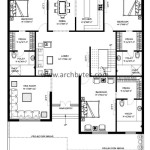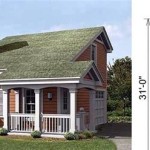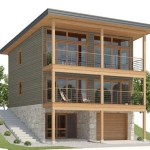4-Bedroom House Plan Cost: A Comprehensive Guide
Building a new home is a significant investment, and understanding the costs associated with a 4-bedroom house plan is crucial for proper budgeting and financial planning. The overall cost can vary considerably depending on a wide range of factors, from the complexity of the design and the quality of materials used to the location of the build and the labor rates in the area. This article provides a detailed exploration of the cost considerations involved in implementing a 4-bedroom house plan.
The initial aspect to address is the distinction between the cost of the house plan itself and the overall cost of constructing the house. A house plan is the blueprint or set of drawings that detail the design, layout, and specifications of the home. The construction cost, on the other hand, encompasses all the expenses associated with physically building the house according to that plan. These are two distinct but interconnected financial components.
A 4-bedroom house generally appeals to families, offering ample space for living, working, and recreation. These houses often include features such as a master suite, multiple bathrooms, a dedicated living area, a kitchen-dining area, and potentially a home office or playroom. The size of a 4-bedroom house can vary significantly, but typically falls within the range of 2,000 to 3,000 square feet, and sometimes even larger, depending on the specific design and the homeowner's needs.
Estimating the cost of a 4-bedroom house plan and its subsequent construction requires a thorough understanding of the various cost components involved. These components can be categorized into several key areas, including the cost of the plan itself, site preparation, materials, labor, permits and fees, and interior finishes. Let us delve into these aspects one by one.
House Plan Cost: Design and Complexity
The cost of a 4-bedroom house plan can vary depending on the source and complexity. Stock plans, which are pre-designed plans available for purchase, generally cost less than custom-designed plans. Stock plans can range from a few hundred dollars to several thousand dollars, depending on the level of detail and completeness offered. These plans may require modifications to suit the specific site conditions or the homeowner's preferences, adding to the overall cost.
Custom-designed plans, on the other hand, are created specifically for the individual client by an architect or a design professional. The cost of a custom plan is substantially higher, typically ranging from 5% to 15% of the total construction cost. This is because custom plans involve a significant amount of design time, consultation, and development of detailed drawings and specifications. The advantage of a custom plan is that it allows for complete personalization and optimization for the specific site and the homeowner's lifestyle.
The complexity of the design also plays a significant role in the cost of the plan. Plans with intricate architectural features, such as multiple roof lines, curved walls, or extensive detailing, will be more expensive due to the increased design and drafting time required. The level of detail included in the plan, such as detailed electrical layouts, plumbing diagrams, and structural specifications, can also affect the cost.
When selecting a house plan, it is crucial to consider the level of detail provided and ensure that it meets the requirements of local building codes and regulations. It is also advisable to consult with a contractor or builder to review the plan and identify any potential challenges or cost implications associated with the design.
Construction Costs: Materials and Labor
The construction cost of a 4-bedroom house is primarily determined by the cost of materials and labor. Material costs encompass all the raw materials required to build the house, including lumber, concrete, roofing, siding, windows, doors, plumbing fixtures, electrical wiring, and HVAC systems. Labor costs cover the wages and benefits paid to the various tradespeople involved in the construction process, such as carpenters, plumbers, electricians, masons, and painters.
Material costs can fluctuate significantly depending on market conditions, supply chain disruptions, and the quality of the materials selected. For example, using high-end finishes, such as granite countertops and hardwood flooring, will be considerably more expensive than using standard-grade materials. Similarly, the choice of roofing material, siding, and windows can significantly impact the overall cost.
Labor costs also vary depending on the location of the build and the availability of skilled tradespeople. Areas with a high cost of living or a shortage of skilled labor typically have higher labor rates. The complexity of the design can also affect labor costs, as intricate architectural features and detailed finishes require more skilled labor and time to complete.
To accurately estimate construction costs, it is essential to obtain detailed bids from multiple contractors. These bids should include a breakdown of material and labor costs, as well as any allowances for unforeseen expenses. It is also advisable to research the reputation and experience of potential contractors and verify their licenses and insurance.
Several strategies can be employed to manage construction costs. Value engineering, which involves identifying cost-saving opportunities without compromising quality or functionality, can be a valuable tool. This may involve selecting alternative materials, simplifying the design, or optimizing the construction process. Careful planning and coordination can also help to minimize delays and reduce labor costs.
Site Preparation, Permits, and Interior Finishing
Site preparation involves preparing the building site for construction, which may include clearing vegetation, grading the land, installing utilities, and pouring the foundation. The cost of site preparation can vary significantly depending on the condition of the land and the complexity of the project. Sites with steep slopes, poor soil conditions, or existing structures may require more extensive and expensive site preparation work.
Permits and fees are required by local governments to ensure that the construction project complies with building codes and regulations. These fees can include building permits, electrical permits, plumbing permits, and impact fees. The cost of permits and fees varies depending on the jurisdiction and the scope of the project.
Interior finishing includes all the work required to complete the interior of the house, such as installing flooring, painting walls, installing cabinetry, and fitting plumbing and electrical fixtures. The cost of interior finishing can vary widely depending on the quality of the materials selected and the level of detail involved. High-end finishes, such as custom cabinetry and designer lighting, can significantly increase the overall cost.
Landscaping and exterior features, such as driveways, patios, and decks, are also important considerations in the overall cost of a 4-bedroom house. These features can enhance the appearance and functionality of the house and add to its overall value. The cost of landscaping and exterior features can vary depending on the scope of the project and the materials selected.
Contingency funds should also be included in the budget to cover unforeseen expenses, such as unexpected site conditions, material price increases, or change orders. A contingency fund of 5% to 10% of the total construction cost is generally recommended. Careful planning, realistic budgeting, and proactive communication with the contractor can help to minimize the need for contingency funds.
The cost of furnishing and decorating the interior of the house is another consideration. This can range from basic furniture and appliances to high-end interior design elements. It's important to factor these post-construction costs into the total budget to avoid financial strain.
The location of the property also influences cost. Building in urban areas often costs more than rural areas due to higher land prices and stricter building codes. Transportation costs for materials and labor can also be higher in certain regions.
Financing is a critical aspect of building a home. Mortgage rates, down payment requirements, and closing costs can significantly affect the overall financial burden. Understanding these aspects and securing appropriate financing is essential.
Homeowners should consider the energy efficiency of the house during the planning stage. Investing in energy-efficient appliances, insulation, and windows can lead to long-term cost savings on utility bills and increase the home's overall value.
Finally, regular communication with the contractor and careful monitoring of the project's progress are essential for staying within budget and addressing any issues that arise promptly. Proactive involvement throughout the construction process can help prevent costly mistakes and ensure that the final product meets the homeowner's expectations.

Building On The Affordable House Plans Of 2024 Houseplans Blog Com

Est House Plans To Build Simple With Style Blog Eplans Com

House Plans 14 4x10 With 4 Bedrooms Samhouseplans

Cost Effective 4 Bedroom Modern Home In Low Budget Free Plan Kerala Plans House

Cost Of Building A 4 Bedroom House

Amazing 4 Bedroom House Plans Home Designs Nethouseplans

29 Lakhs Cost Effective 4 Bedroom Home With Free Plan Kerala Plans Building House Affordable Model

4 Bedroom House Plan In Village Bhk Home Plans Simple Low Budget

4 Bedroom House Designs In Kenya To Inspire Your Next Build Co Ke

Low Cost Single Story 4 Bedroom House Floor Plans Country Farm 2200 Sf One Level
Related Posts








